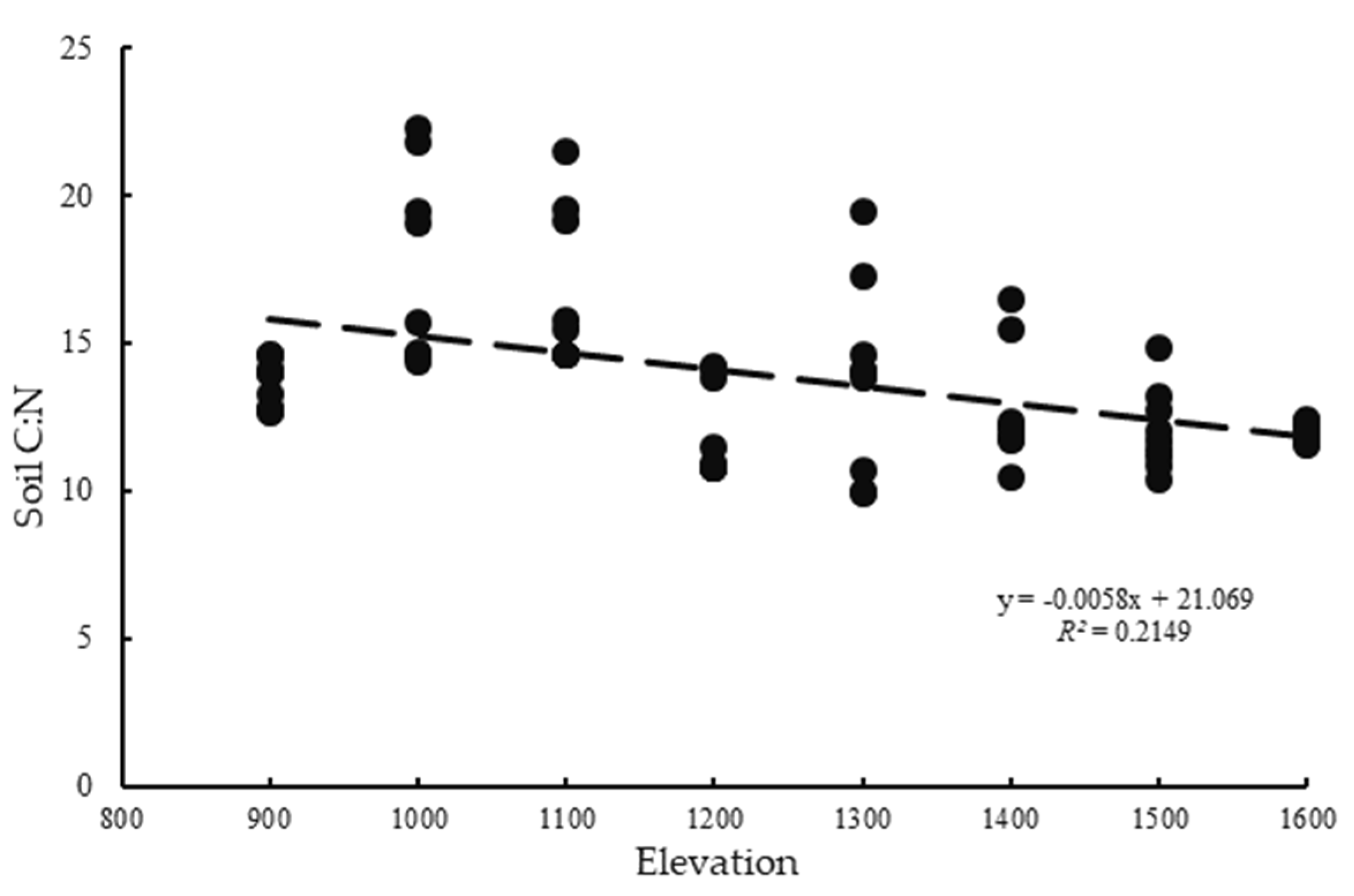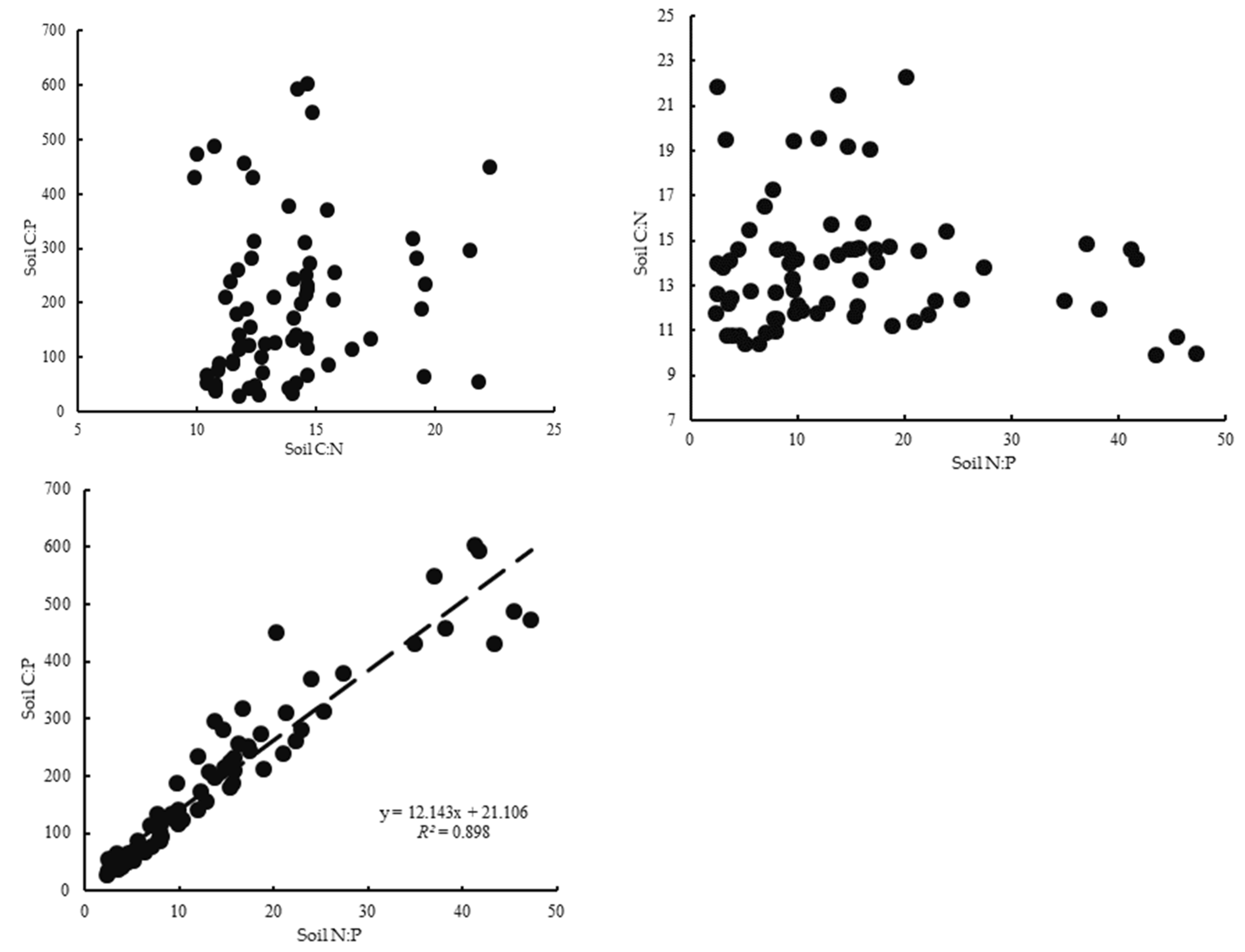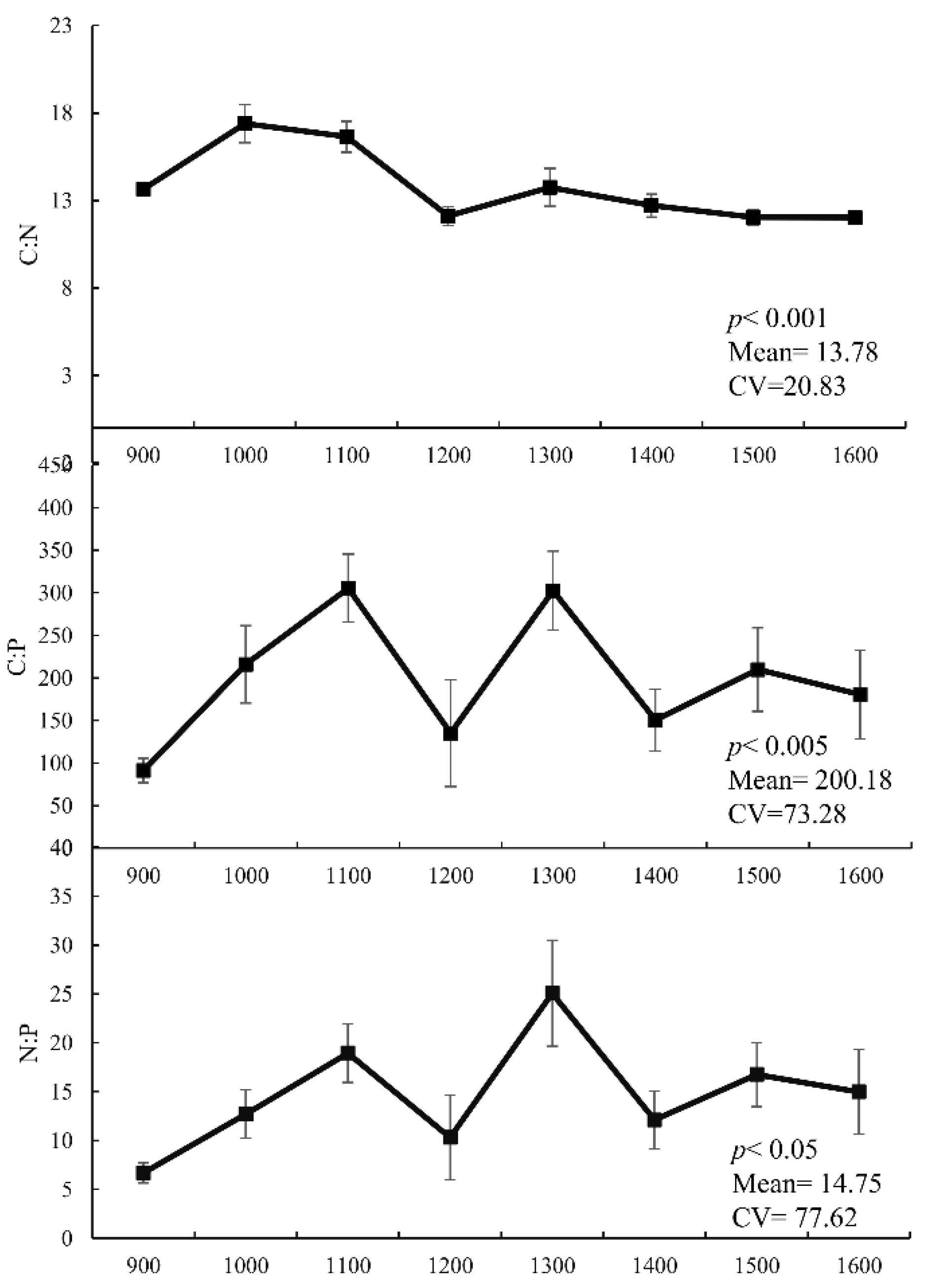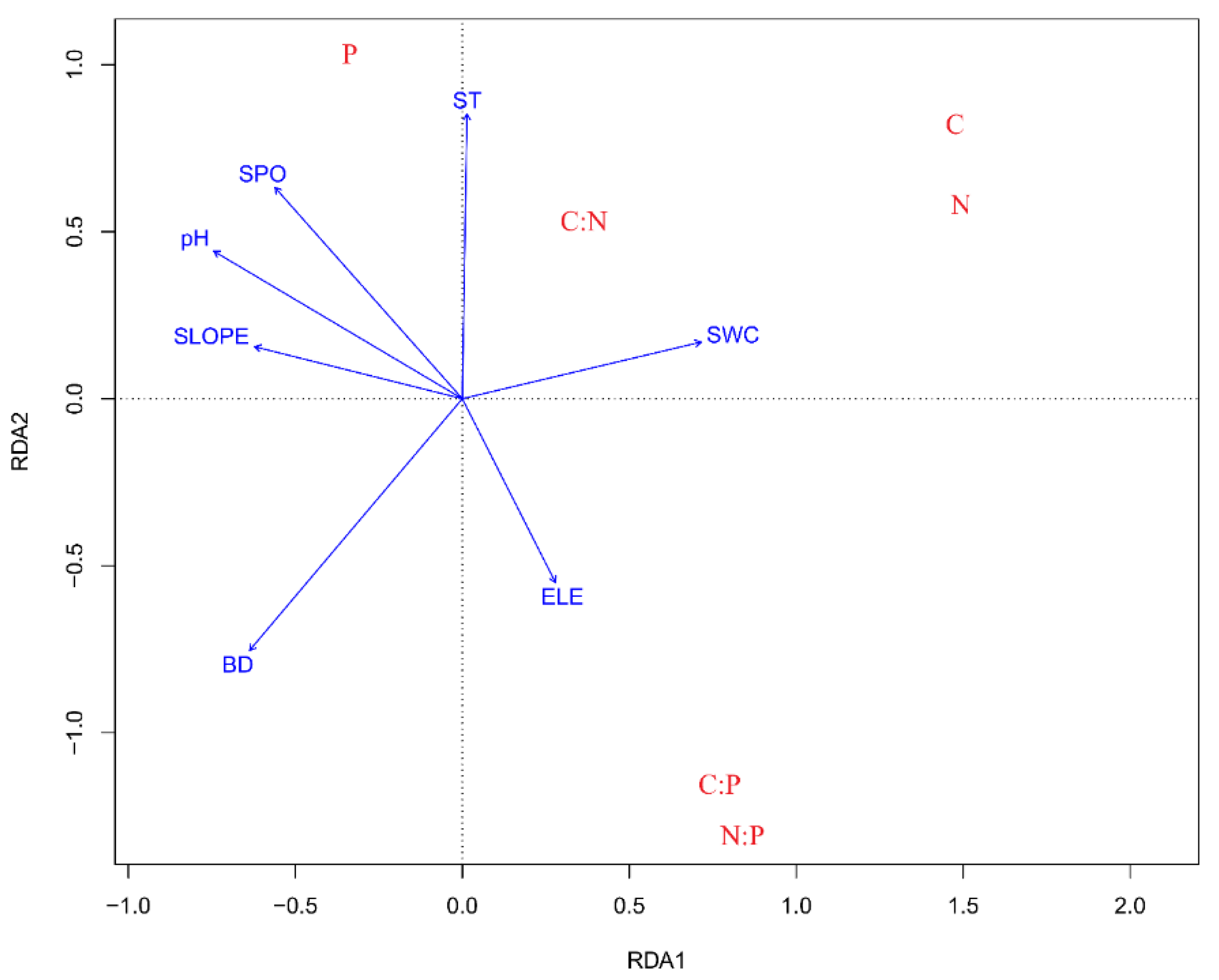Elevation Gradient Altered Soil C, N, and P Stoichiometry of Pinus taiwanensis Forest on Daiyun Mountain
Abstract
1. Introduction
2. Materials and Methods
2.1. Study Site
2.2. Sample Plot Setting
2.3. Data Collection
2.4. Data Analysis
3. Results
3.1. Distribution Characteristics of Soil Physical and Chemical Properties
3.2. Soil C, N, and P and Their Stoichiometry Changes Along Elevation Gradients
3.3. Correlation Analysis Between Soil Nutrient Elements and Soil Stoichiometry
3.4. Correlation Between Soil Stoichiometry and Environmental Factors
4. Discussion
4.1. Elevation Heterogeneity of Soil Stoichiometry
4.2. Relationship of Soil Nutrients and Stoichiometry on Daiyun Mountain
4.3. Environmental Factors Affecting Differences in Soil Stoichiometry Along Elevation Gradients
5. Conclusions
Author Contributions
Funding
Acknowledgments
Conflicts of Interest
Appendix A

| Elevation | Margalef | Simpson | Shannon–Wiener | Pielou |
|---|---|---|---|---|
| 900 | 4.904 | 0.838 | 2.525 | 0.722 |
| 1000 | 5.739 | 0.849 | 2.665 | 0.738 |
| 1100 | 4.449 | 0.831 | 2.390 | 0.717 |
| 1200 | 6.094 | 0.921 | 2.973 | 0.830 |
| 1300 | 4.779 | 0.915 | 2.856 | 0.817 |
| 1400 | 4.483 | 0.874 | 2.643 | 0.763 |
| 1500 | 3.549 | 0.861 | 2.558 | 0.795 |
| 1600 | 2.792 | 0.845 | 2.345 | 0.770 |
| R2 | F-Value | p-Value | Slope | Intercept | |
|---|---|---|---|---|---|
| C:N-elevation | 0.215 | 18.615 | 0 | −0.006 | 21.069 |
| C:P-elevation | 0.003 | 0.235 | 0.629 | ||
| N:P-elevation | 0.032 | 2.228 | 0.14 |
| RDA1 | RDA2 | R2 | p | |
|---|---|---|---|---|
| SPO | −0.6974 | 0.7167 | 0.0541 | 0.152 |
| pH | −0.9035 | 0.4287 | 0.0585 | 0.145 |
| ST | 0.1124 | 0.9937 | 0.0587 | 0.147 |
| SLOPE | −0.9895 | 0.1446 | 0.0338 | 0.328 |
| ELE | 0.4424 | −0.8968 | 0.0289 | 0.398 |
| SWC | 0.9609 | 0.2769 | 0.0482 | 0.186 |
| BD | −0.6941 | −0.7199 | 0.0877 | 0.047 * |

References
- Unteregelsbacher, S.; Hafner, S.; Guggenberger, G.; Miehe, G.; Xu, X.L.; Liu, J.Q.; Kuzyakov, Y. Response of long-, medium- and short-term processes of the carbon budget to overgrazing-induced crusts in the Tibetan Plateau. Biogeochemistry 2012, 111, 187–201. [Google Scholar] [CrossRef]
- Wassen, M.J.; Venterink, H.O.; Swart, E.A. Nutrient Concentrations in Mire Vegetation as a Measure of Nutrient Limitation in Mire Ecosystems. J. Veg. Sci. 1995, 6, 5–16. [Google Scholar] [CrossRef]
- Reich, P.B.; Tjoelker, M.G.; Machado, J.L.; Oleksyn, J. Universal scaling of respiratory metabolism, size and nitrogen in plants. Nature 2006, 439, 457–461. [Google Scholar] [CrossRef]
- Mao, R.; Zhang, X.H.; Li, S.Y.; Song, C.C. Long-term phosphorus addition enhances the biodegradability of dissolved organic carbon in a nitrogen-limited temperate freshwater wetland. Sci. Total Environ. 2017, 332–336. [Google Scholar] [CrossRef] [PubMed]
- Zhang, Z.C.; Hou, G.; Liu, M.; Wei, T.X.; Sun, J. Degradation induces changes in the soil C:N:P stoichiometry of alpine steppe on the Tibetan Plateau. J. Mt. Sci. 2019, 16, 2348–2360. [Google Scholar] [CrossRef]
- Evans, J.R. Photosynthesis and nitrogen relationships in leaves of C3 plants. Oecologia 1989, 78, 9–19. [Google Scholar] [CrossRef]
- He, J.S.; Han, X.G. Ecological stoichiometry: Searching for unifying principles from individuals to ecosystems. Chin. J. Plant Ecol. 2010, 34, 2–6. [Google Scholar]
- Li, T.Y.; Wang, C.Y.; He, B.H.; Liang, C.; Zhang, Y.; Zhang, Y.Q. Soil nutrient concentrations and stoichiometry under different tree-cropping systems in a purple hillslope in southwestern China. Arch. Agron. Soil Sci. 2019, 65, 741–754. [Google Scholar] [CrossRef]
- Yang, X.X.; Dong, Q.M.; Chun, H.; Ding, C.X.; Yu, Y.; Zhang, C.P.; Zhang, Y.F.; Yang, Z.Z. Different responses of soil element contents and their stoichiometry (C:N:P) to yak grazing and Tibetan sheep grazing in an alpine grassland on the eastern Qinghai-Tibetan Plateau. Agric. Ecosyst. Environ. 2019, 285, 106628. [Google Scholar] [CrossRef]
- Su, L.; Du, H.; Zeng, F.P.; Peng, W.X.; Rizwan, M.; Núnez-Delgado, A.; Zhou, Y.Z.; Zhou, Y.Y.; Song, T.Q.; Wang, H. Soil and fine roots ecological stoichiometry in different vegetation restoration stages in a karst area, southwest China. J. Environ. Manag. 2019, 252, 109694. [Google Scholar] [CrossRef]
- Lucas-Borja, M.E.; Delgado-Baquerizo, M. Plant diversity and soil stoichiometry regulates the changes in multifunctionality during pine temperate forest secondary succession. Sci. Total Environ. 2019, 697, 134204. [Google Scholar] [CrossRef] [PubMed]
- Zhang, B.; Xue, K.; Zhou, S.T.; Che, R.X.; Du, J.Q.; Tang, L.; Pang, Z.; Wang, F.; Wang, D.; Cui, X.Y.; et al. Phosphorus mediates soil prokaryote distribution pattern along a small-scale elevation gradient in Noijin Kangsang Peak, Tibetan Plateau. FEMS Microbiol. Ecol. 2019, 95, fiz076. [Google Scholar] [CrossRef] [PubMed]
- Zhang, M.; Zhang, X.K.; Liang, W.J.; Jiang, Y.; Dai, G.H.; Wang, X.G.; Han, S.J. Distribution of Soil Organic Carbon Fractions Along the Altitudinal Gradient in Changbai Mountain, China. Pedosphere 2011, 21, 615–620. [Google Scholar] [CrossRef]
- Zhao, F.; Li, D.D.; Jiao, F.; Yao, J.; Du, H.T. The Latitudinal Patterns of Leaf and Soil C:N:P Stoichiometry in the Loess Plateau of China. Front. Plant Sci. 2019, 10. [Google Scholar]
- Hu, C.; Li, F.; Xie, Y.H.; Deng, Z.M.; Chen, X.S. Soil carbon, nitrogen, and phosphorus stoichiometry of three dominant plant communities distributed along a small-scale elevation gradient in the East Dongting Lake. Phys. Chem. Earth 2017, 103, 28–34. [Google Scholar] [CrossRef]
- Zhang, Y.; Li, C.; Wang, M.L. Linkages of C: N: P stoichiometry between soil and leaf and their response to climatic factors along altitudinal gradients. J. Soils Sediments 2018, 19, 1820–1829. [Google Scholar] [CrossRef]
- Muller, M.; Yvonne, O.; Schickhoff, U.; Bohner, J.; Scholten, T. Himalayan treeline soil and foliar C:N:P stoichiometry indicate nutrient shortage with elevation. Geoderma 2017, 291, 21–32. [Google Scholar] [CrossRef]
- He, X.J.; Hou, E.Q.; Liu, Y.; Wen, D.Z. Altitudinal patterns and controls of plant and soil nutrient concentrations and stoichiometry in subtropical China. Sci. Rep. 2016, 6, 24261. [Google Scholar] [CrossRef]
- Xu, D.W.; Liu, J.F.; Peter, M.; He, Z.S.; Zheng, S.Q. Leaf litter decomposition dynamics in unmanaged Phyllostachys pubescens stands at high elevations in the Daiyun Mountain National Nature Reserve. J. Mt. Sci. 2017, 14, 2246–2256. [Google Scholar] [CrossRef]
- Su, S.J.; Liu, J.F.; He, Z.S.; Zheng, S.Q.; Hong, W.; Xu, D.W. Ecological species groups and interspecific association of dominant tree species in Daiyun Mountain National Nature Reserve. J. Mt. Sci. 2015, 12, 637–646. [Google Scholar] [CrossRef]
- Su, S.J.; Liu, J.F.; Chen, W.W.; Kuang, K.J.; Tang, R.; Hong, W. Spatial Variability and Patterns of Soil Moisture Physical Properties in Pinus taiwanensis Forest Based on Geostatistics and GIS. Resour. Sci. 2014, 36, 2423–2430. (In Chinese) [Google Scholar]
- Liu, J.F.; Zhu, D.H.; Lan, S.R.; Hong, W.; Zheng, S.Q.; He, Z.S.; Xu, D.W. Association between environment and community of Pinus taiwanensis in Daiyun Mountain. Acta Ecol. Sin. 2013, 33, 5731–5736. (In Chinese) [Google Scholar]
- Deckers, J.; Driessen, P.; Nachtergaele, F.O.; Spaargaren, O. World Reference Base for Soil Resources. Eppo Bull. 1998, 1446–1451. [Google Scholar]
- Zhu, J.J.; Mao, Z.H.; Hu, L.L.; Zhang, J.X. Plant diversity of secondary forests in response to anthropogenic disturbance levels in montane regions of northeastern China. J. For. Res. 2007, 12, 403–416. [Google Scholar] [CrossRef]
- People’s Republic of China Forestry Industry Standard. Forest Soil Analysis Method; The State Forestry Administration of the People’s Republic of China: Beijing, China, 1999; pp. 71–113. (In Chinese)
- R Core Team. R: A Language and Environment for Statistical Computing; R Foundation for Statistical Computing: Vienna, Austria, 2017; Available online: http://www.R-project.org/ (accessed on 4 July 2018).
- Paul, K.I.; Polglase, P.J.; Nyakuengama, J.G.; Khanna, P.K. Change in soil carbon following afforestation. For. Ecol. Manag. 2002, 168, 241–257. [Google Scholar] [CrossRef]
- Tian, H.Q.; Chen, G.S.; Zhang, C.; Melillo, J.M.; Hall, C.A. Pattern and variation of C:N:P ratios in China’s soils: A synthesis of observational data. Biogeochemistry 2010, 98, 139–151. [Google Scholar] [CrossRef]
- Batjes, N.H. Total carbon and nitrogen in the soils of the world. Eur. J. Soil Sci. 2010, 47, 151–163. [Google Scholar] [CrossRef]
- Tessier, J.T. Vernal Photosynthesis and Nutrient Retranslocation in Dryopteris intermedia. Am. Fern J. 2001, 91, 187–196. [Google Scholar] [CrossRef]
- Mcgroddy, M.E.; Daufresne, T.; Hedin, L.O. Scaling of C:N:P stoichiometry in forest worldwide: Implications of terrestrial Redfield-type ratios. Ecology 2004, 85, 2390–2401. [Google Scholar] [CrossRef]
- Acquaye, D.K.; Kang, B.T. Sulfur status and forms in some surface soils of Ghana. Soil Sci. 1987, 144, 43–52. [Google Scholar] [CrossRef]
- Potapov, A.M.; Goncharov, A.A.; Semenina, E.E.; Korotkevich, A.Y.; Tsurikov, S.M.; Rozanova, O.L.; Akichkin, A.E.; Zuev, A.G.; Symcylova, E.S.; Semenyuk, L.L.; et al. Arthropods in the subsoil: Abundance and vertical distribution as related to soil organic matter, microbial biomass and plant roots. Eur. J. Soil Biol. 2017, 82, 88–97. [Google Scholar] [CrossRef]
- Cleveland, C.C.; Liptzin, D. C:N:P Stoichiometry in Soil: Is There a “Redfield Ratio” for the Microbial Biomass? Biogeochemistry 2007, 85, 235–252. [Google Scholar] [CrossRef]
- Cao, Y.E.; Wang, Y.; Xu, Z.L. Soil C:P Ratio along Elevational Gradients in Picea schrenkiana Forest of Tianshan Mountains. Pol. J. Ecol. 2019, 66, 325–336. [Google Scholar] [CrossRef]
- Zhang, X.Y.; Liu, M.Z.; Zhao, X.; Li, Y.Q.; Zhao, W.; Li, A.; Chen, S.; Chen, S.P.; Han, X.G.; Huang, J.H. Topography and grazing effects on storage of soil organic carbon and nitrogen in the northern China grasslands. Ecol. Indic. 2018, 93, 45–53. [Google Scholar] [CrossRef]
- Yang, Y.H.; Luop, Y.Q. Carbon: Nitrogen stoichiometry in forest ecosystems during stand development. Glob. Ecol. Biogeogr. 2011, 20, 354–361. [Google Scholar] [CrossRef]
- Li, L.; Chang, Y.P.; Xu, Z.L. Stoichiometric characteristics of Picea schrenkiana forests with a hydrothermal gradient and their correlation with soil physicochemical factors on Tianshan Mountain. Acta Ecol. Sin. 2018, 38, 8139–8148. [Google Scholar]
- Olander, L.P.; Vitousek, P.M. Regulation of soil phosphatase and chitinase activity by N and P availability. Biogeochemistry 2000, 49, 175–190. [Google Scholar] [CrossRef]
- Cheng, M.; An, S.S. Responses of soil nitrogen, phosphorous and organic matter to vegetation succession on the Loess Plateau of China. J. Arid Land 2015, 7, 216–223. [Google Scholar] [CrossRef]
- Tian, L.M.; Zhao, L.; Wu, X.D.; Fang, H.B.; Zhao, Y.H.; Hu, G.J.; Yue, G.Y.; Sheng, Y.; Wu, J.C.; Chen, J.; et al. Soil moisture and texture primarily control the soil nutrient stoichiometry across the Tibetan grassland. Sci. Total Environ. 2017, 622–623, 192–202. [Google Scholar] [CrossRef]
- Vitousek, P.M.; Aplet, G.H.; Turner, D.R.; Lockwood, J.J. The Mauna Loa environmental matrix: Foliar and soil nutrients. Oecologia 1992, 89, 372–382. [Google Scholar] [CrossRef]
- Fisher, J.B.; Malhi, Y.; Torres, I.C.; Metcalfe, D.B.; Weg, M.J.; Meir, P.; Silva-Espejo, J.E.; Huasco, W.H. Nutrient limitation in rainforests and cloud forests along a 3,000-m elevation gradient in the Peruvian Andes. Oecologia 2013, 172, 889–902. [Google Scholar] [CrossRef] [PubMed]
- Unger, M.; Leuschner, C.; Homeier, J. Variability of indices of macronutrient availability in soils at different spatial scales along an elevation transect in tropical moist forests. Plant Soil 2010, 336, 443–458. [Google Scholar] [CrossRef]
- Tipping, E.; Somerville, C.J.; Luster, J. The C:N:P:S stoichiometry of soil organic matter. Biogeochemistry 2016, 130, 117–131. [Google Scholar] [CrossRef]
- Buchkowski, R.W.; Schmitz, O.J.; Bradford, M.A. Microbial stoichiometry overrides biomass as a regulator of soil carbon and nitrogen cycling. Ecology 2015, 96, 1139–1149. [Google Scholar] [CrossRef]
- Wang, H.; Liu, S.R.; Wang, J.X.; Shi, Z.M.; Xu, J.; Hong, P.Z.; Ming, A.G.; Yu, H.L.; Chen, L.; Lu, L.H.; et al. Differential effects of conifer and broadleaf litter inputs on soil organic carbon chemical composition through altered soil microbial community composition. Sci. Rep. 2016, 6, 27097. [Google Scholar] [CrossRef]
- Wang, K.; Lei, H.; Shi, L.; Zhang, R.S.; Song, L.N. Soil carbon, nitrogen and phosphorus stoichiometry characteristics of Pinus sylvestris var mongolica belt-mixed forests. Chin. J. Appl. Ecol. 2019, 30, 2883–2891. (In Chinese) [Google Scholar]
- Giardina, C.P.; Huffman, S.; Binkley, D.; Caldwell, B.A. Alders increase soil phosphorus availability in a Douglas-fir plantation. Can. J. For. Res. 1995, 25, 1652–1657. [Google Scholar] [CrossRef]



| Plot Number | Elevation | Longitude | Latitude | Vegetation Type [18] | Dominant Species | Slope | Slope Position |
|---|---|---|---|---|---|---|---|
| DYS-900 | 915 | 118°10′36″ | 25°38′46″ | CEBF | Cyclobalanopsis glauca; Cunninghamia lanceolata | 28~38 | mid-slope |
| DYS-1000 | 1001 | 118°10′38″ | 25°38′51″ | CEBF | C. lanceolata; C. glauca | 35~35 | upper-slope |
| DYS-1100 | 1091 | 118°10′43″ | 25°38′57″ | CEBF | C. lanceolata; C. glauca | 35~50 | mid-slope |
| DYS-1200 | 1201 | 118°10′53″ | 25°39′06″ | CEBF | C. lanceolata; Machilus thunbergii | 15~33 | mid-slope |
| DYS-1300 | 1321 | 118°10′55″ | 25°39′22″ | CEBF | Eurya rubiginosa var. attenuate; Pinus taiwanensis | 14~27 | down-slope |
| DYS-1400 | 1411 | 118°10′58″ | 25°39′32″ | CEBF | P. taiwanensis; E. rubiginosa var. attenuate | 26~31 | upper-slope |
| DYS-1500 | 1501 | 118°10′57″ | 25°39′47″ | CF | P. taiwanensis | 22~34 | down-slope |
| DYS-1600 | 1613 | 118°11′05″ | 25°40′06″ | CF | P. taiwanensis | 31~32 | mid-slope |
| Elevation | C (g·kg−1) | N (g·kg−1) | Log P (g·kg−1) | pH | Soil Water Content (%) | Soil Bulk Density (g·cm−3) | Soil Temperature (°C) |
|---|---|---|---|---|---|---|---|
| 900 | 46.28 ± 1.84 | 3.38 ± 0.08 | −0.24 ± 0.09 | 3.82 ± 0.02 a | 35.56 ± 1.91 | 0.7 ± 0.04 c,d | 23.2 ± 0.2 a |
| 1000 | 74.11 ± 4.9 | 4.31 ± 0.25 | −0.37 ± 0.11 | 3.65 ± 0.05 c | 41.85 ± 2.94 | 0.64 ± 0.03 d | 22.6 ± 0.2 b |
| 1100 | 52.63 ± 1.53 | 3.21 ± 0.1 | −0.74 ± 0.05 | 3.7 ± 0.05 a,b,c | 43.9 ± 1.92 | 0.68 ± 0.04 c,d | 21.5 ± 0.1 c |
| 1200 | 39.18 ± 7.29 | 3.12 ± 0.44 | −0.35 ± 0.11 | 3.83 ± 0.02 a | 44.25 ± 2.14 | 0.8 ± 0.03 a,b,c | 21.4 ± 0.1 c |
| 1300 | 63.57 ± 10.31 | 4.39 ± 0.55 | −0.59 ± 0.19 | 3.61 ± 0.03 c | 47.83 ± 4.51 | 0.76 ± 0.06 b,c,d | 21.2 ± 0.2 c |
| 1400 | 41.24 ± 4.4 | 3.36 ± 0.41 | −0.72 ± 0.14 | 3.58 ± 0.04 c | 43.69 ± 6.58 | 0.86 ± 0.03 a,b | 20.4 ± 0.1 d |
| 1500 | 56.56 ± 8.19 | 4.57 ± 0.53 | −0.52 ± 0.08 | 3.8 ± 0.05 a,b | 53.33 ± 5.51 | 0.77 ± 0.07 b,c,d | 19.8 ± 0.1 e |
| 1600 | 50.7 ± 3.54 | 4.21 ± 0.28 | −0.39 ± 0.15 | 3.68 ± 0.05 b,c | 44.54 ± 2.37 | 0.92 ± 0.05 a | 19.0 ± 0.1 f |
| Mean ± SE | 53.03 ± 2.39 | 3.82 ± 0.14 | −0.49 ± 0.05 | 3.71 ± 0.02 | 44.41 ± 1.30 | 0.77 ± 0.02 | 21.1 ± 0.2 |
| CV | 38.30 | 31.58 | 77.77 | 4.03 | 20.24 | 20.83 | 6.50 |
| F | 3.769 | 2.587 | 2.073 | 4.117 | 5.268 | 1.682 | 108.808 |
| p | 0.002 | 0.021 | 0.059 | 0.001 | 0.000 | 0.141 | 0.000 |
| p-adjusted | 0.056 | 0.588 | 1.652 | 0.028 | 0.000 | 3.948 | 0.000 |
| C | N | P | C:N | C:P | N:P | ||
|---|---|---|---|---|---|---|---|
| C | Pearson Correlation | 1 | 0.869 ** | 0.162 | 0.580 ** | 0.245 * | 0.064 |
| Sig. (2-tailed) | 0.000 | 0.000 | 0.177 | 0.000 | 0.041 | 0.596 | |
| N | Pearson Correlation | 0.869 ** | 1 | 0.106 | 0.126 | 0.205 | 0.137 |
| Sig. (2-tailed) | 0.000 | 0.000 | 0.378 | 0.291 | 0.089 | 0.258 | |
| P | Pearson Correlation | 0.162 | 0.106 | 1 | 0.108 | −0.591 ** | −0.575 ** |
| Sig. (2-tailed) | 0.177 | 0.378 | 0.000 | 0.370 | 0.000 | 0.000 | |
| C:N | Pearson Correlation | 0.580 ** | 0.126 | 0.108 | 1 | 0.140 | −0.122 |
| Sig. (2-tailed) | 0.000 | 0.291 | 0.370 | 0.000 | 0.249 | 0.315 | |
| C:P | Pearson Correlation | 0.245 * | 0.205 | −0.591 ** | 0.140 | 1 | 0.948 ** |
| Sig. (2-tailed) | 0.041 | 0.089 | 0.000 | 0.249 | 0.000 | 0.000 | |
| N:P | Pearson Correlation | 0.064 | 0.137 | −0.575 ** | −0.122 | 0.948 ** | 1 |
| Sig. (2-tailed) | 0.596 | 0.258 | 0.000 | 0.315 | 0.000 | 0.000 |
| Ordination Information | Value |
|---|---|
| The largest axis length of DCA | 0.9747 |
| The sum of first two axis of RDA | 0.9323 |
| The sum of eigenvalues for constrained axes in RDA | 1.308 |
| Cumulative percentage of stoichiometry environment variation the first two axes in RDA | 71.28% |
| Total eigenvalues of RDA | 6.0000 |
| Total explanatory proportion of environmental factors | 21.80% |
| Significance test for all axes | p = 0.001 |
| AIC | BIC | Environment | Estimate | Std.Error | t-Value | p | |
|---|---|---|---|---|---|---|---|
| C | 614 | 626 | ELE | 0.078 | 0.028 | 2.790 | 0.0069 |
| BD | −37.601 | 15.666 | −2.400 | 0.0192 | |||
| ST | 12.319 | 4.534 | 2.717 | 0.0084 | |||
| N | 215 | 227 | ELE | 0.006 | 0.002 | 3.785 | 0.0003 |
| BD | −2.138 | 0.906 | −2.359 | 0.0212 | |||
| ST | 0.738 | 0.262 | 2.813 | 0.0065 | |||
| P | 71.9 | 80.9 | SPO | 0.117 | 0.057 | 2.052 | 0.0441 |
| pH | 0.647 | 0.346 | 1.873 | 0.0654 | |||
| C:N | 333 | 342 | pH | −0.006 | 0.001 | −4.432 | 0.0000 |
| ELE | −5.856 | 2.213 | −2.646 | 0.0101 | |||
| C:P | 895 | 904 | SPO | −49.95 | 20.35 | −2.455 | 0.0167 |
| pH | −281.87 | 123.24 | −2.287 | 0.0254 | |||
| N:P | 539 | 548 | SPO | −3.34 | 1.608 | −2.080 | 0.0414 |
| pH | −21.13 | 9.739 | −2.17 | 0.0336 |
© 2019 by the authors. Licensee MDPI, Basel, Switzerland. This article is an open access article distributed under the terms and conditions of the Creative Commons Attribution (CC BY) license (http://creativecommons.org/licenses/by/4.0/).
Share and Cite
Jiang, L.; He, Z.; Liu, J.; Xing, C.; Gu, X.; Wei, C.; Zhu, J.; Wang, X. Elevation Gradient Altered Soil C, N, and P Stoichiometry of Pinus taiwanensis Forest on Daiyun Mountain. Forests 2019, 10, 1089. https://doi.org/10.3390/f10121089
Jiang L, He Z, Liu J, Xing C, Gu X, Wei C, Zhu J, Wang X. Elevation Gradient Altered Soil C, N, and P Stoichiometry of Pinus taiwanensis Forest on Daiyun Mountain. Forests. 2019; 10(12):1089. https://doi.org/10.3390/f10121089
Chicago/Turabian StyleJiang, Lan, Zhongsheng He, Jinfu Liu, Cong Xing, Xinguang Gu, Chensi Wei, Jing Zhu, and Xuelin Wang. 2019. "Elevation Gradient Altered Soil C, N, and P Stoichiometry of Pinus taiwanensis Forest on Daiyun Mountain" Forests 10, no. 12: 1089. https://doi.org/10.3390/f10121089
APA StyleJiang, L., He, Z., Liu, J., Xing, C., Gu, X., Wei, C., Zhu, J., & Wang, X. (2019). Elevation Gradient Altered Soil C, N, and P Stoichiometry of Pinus taiwanensis Forest on Daiyun Mountain. Forests, 10(12), 1089. https://doi.org/10.3390/f10121089





